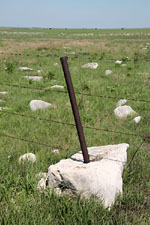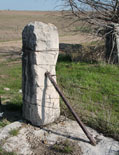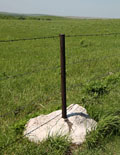
|
J.S. and S.W. Aber |
| Introduction | Kansa Indians | |||
| Exoduster Cemetery | Exoduster update | Dunlap Cemetery
| Dunlap Bottoms | References & related | |

|
J.S. and S.W. Aber |
| Introduction | Kansa Indians | |||
| Exoduster Cemetery | Exoduster update | Dunlap Cemetery
| Dunlap Bottoms | References & related | |
Back to top.
Iris and peonies were in full bloom, and the surrounding prairie was a carpet of green. The cemetery is located on a hill top next to an outcrop of the Cottonwood Limestone, which is prominent in this vicinity. Stone blocks quarried by exodusters in the late 19th century from the Cottonwood Limestone were used to manufacture distinctive stone fence posts that continue in use today throughout the region.
Back to top.
Back to top.
We began to conduct kite aerial photography in the spring of 2015, which turned out to be an unusually wet year (see NOAA). The winter and early spring of 2016, in contrast, were relatively dry. Late April rains dumped several inches (>10 cm) of rain in the vicinity, however, which filled the pools and triggered vegetation greenup. The site was quite muddy, for which the cargo dolly proved useful.
Introduction
Dunlap is located in the Neosho River valley at the eastern edge of the Flint Hills, which includes the largest tract of tallgrass prairie that still exists in the United States. Owing to rocky soils and steep slopes, crop agriculture is limited mainly to bottomland soil in valleys. Cattle grazing is the primary land use, and ranchers employ controlled burning to maintain the prairie grasses (Hoy 1993). The Flint Hills embody the archetype of the American prairie, and as such the region has become a destination for ecotourism and scientific research (Aber and Aber 2009). The Dunlap vicinity witnessed two important chapters in the history of Kansas (Hickey 1990).

Left: remains of the African-American (exoduster) Baptist Church in Dunlap (2014). Church walls collapsed and were removed the following year. Right: Dunlap Colored Cemetery, established in 1880.

Diminished Kansa Reserve
We (JSA & MS) undertook kite aerial photography at the Kansa Diminished Reserve site near Dunlap under light-wind conditions in mid-April 2014. We set up beside a county road. Spring burning was underway in many locations throughout the Flint Hills, which made for a smoky haze, and burning had been done within the past week in this vicinity. The charred prairie contrasted dramatically with green fields of winter wheat. Dunlap Colored Cemetery
In mid-May 2014, we (JSA & JS) had the opportunity for KAP at the African-American (exoduster) cemetery, official known as the Dunlap Colored Cemetery, about one mile northeast of Dunlap and half a mile north of the city cemetery. A gusty south wind made for somewhat difficult kite handling, but our big rokkaku easily lifted the radio-controlled Nikon GPS camera rig.

Right: limestone block with steel post set into the stone.

Dunlap Colored Cemetery – 2021 update
In late April 2021, we revisited the Dunlap Colored Cemetery for ground photos and noted several improvements. The cemetery was placed on the National Register of Historic Places in 2018. According to the registration summary, headstones are arranged in approximately 17 rows, although uneven rows and random headstones are found throughout the cemetery. An estimated total of 125-130 graves are present, but additional unmarked graves may exist. Many graves originally had stones without inscription or simple wooden crosses. The latter are long gone from rot, wind, and prairie fires.

Plaque mounted on a stone gate post at the entrance to the Dunlap Colored Cemetery.
Dunlap Cemetery
The Dunlap Cemetery is located on a hill top about one-half mile east of Dunlap. We (JSA & SWA) conducted KAP here in early May 2014 about a month after spring burning in the vicinity. Tallgrass prairie was greening up along with lush fields of winter wheat. Weather conditions were somewhat unsettled with a gusty south wind and variable cloud cover racing by. This made for some interesting sky and cloud views, but we had some equipment issues. We tried three kites, first a small rokkaku, and our large Strato-spool reel suffered a mechanical failure.

Notice the distinctive stone fence posts (right).



Dunlap Bottoms
Dunlap Bottoms is one of several natural areas owned and maintained by Emporia State University. It is located immediatly southeast of the city of Dunlap. The natural area covers 128 acres (52 hectares) of former agricultural land in the Neosho River valley floodplain. The site is part of the USDA Wetland Reserve Program and has been partially restored for wetland habitat. An old and long-abandoned railroad right-of-way runs along one side; the other sides are bordered by county roads and agricultural fields. ![]()
References
![]() Related sites
Related sites
![]() Return to KAP home or gallery.
Return to KAP home or gallery.
All text and imagery © by J.S. and S.W. Aber.
Last update June 2021.